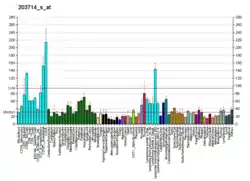| TBCE | |||||||||||||||||||||||||||||||||||||||||||||||||||
|---|---|---|---|---|---|---|---|---|---|---|---|---|---|---|---|---|---|---|---|---|---|---|---|---|---|---|---|---|---|---|---|---|---|---|---|---|---|---|---|---|---|---|---|---|---|---|---|---|---|---|---|
| |||||||||||||||||||||||||||||||||||||||||||||||||||
| Identifiers | |||||||||||||||||||||||||||||||||||||||||||||||||||
| Aliases | TBCE, HRD, KCS, KCS1, pac2, tubulin folding cofactor E, PEAMO | ||||||||||||||||||||||||||||||||||||||||||||||||||
| External IDs | OMIM: 604934 MGI: 1917680 HomoloGene: 37744 GeneCards: TBCE | ||||||||||||||||||||||||||||||||||||||||||||||||||
| |||||||||||||||||||||||||||||||||||||||||||||||||||
| |||||||||||||||||||||||||||||||||||||||||||||||||||
| |||||||||||||||||||||||||||||||||||||||||||||||||||
| |||||||||||||||||||||||||||||||||||||||||||||||||||
| Wikidata | |||||||||||||||||||||||||||||||||||||||||||||||||||
| |||||||||||||||||||||||||||||||||||||||||||||||||||
Tubulin-specific chaperone E is a protein that in humans is encoded by the TBCE gene.[4][5]
Cofactor E is one of four proteins (cofactors A, D, E, and C) involved in the pathway leading to correctly folded beta-tubulin from folding intermediates. Cofactors A and D are believed to play a role in capturing and stabilizing beta-tubulin intermediates in a quasi-native confirmation. Cofactor E binds to the cofactor D/beta-tubulin complex; interaction with cofactor C then causes the release of beta-tubulin polypeptides that are committed to the native state. Two transcript variants encoding the same protein have been found for this gene.[5]
The TBCE gene is either deleted or mutated in Sanjad-Sakati Syndrome
References
- 1 2 3 GRCm38: Ensembl release 89: ENSMUSG00000039233 - Ensembl, May 2017
- ↑ "Human PubMed Reference:". National Center for Biotechnology Information, U.S. National Library of Medicine.
- ↑ "Mouse PubMed Reference:". National Center for Biotechnology Information, U.S. National Library of Medicine.
- ↑ Tian G, Huang Y, Rommelaere H, Vandekerckhove J, Ampe C, Cowan NJ (Sep 1996). "Pathway leading to correctly folded beta-tubulin". Cell. 86 (2): 287–96. doi:10.1016/S0092-8674(00)80100-2. PMID 8706133. S2CID 18359371.
- 1 2 "Entrez Gene: TBCE tubulin folding cofactor E".
Further reading
- Lewis SA, Tian G, Vainberg IE, Cowan NJ (1996). "Chaperonin-mediated folding of actin and tubulin". J. Cell Biol. 132 (1–2): 1–4. doi:10.1083/jcb.132.1.1. PMC 2120700. PMID 8567715.
- Parvari R, Diaz GA, Hershkovitz E (2007). "Parathyroid development and the role of tubulin chaperone E". Horm. Res. 67 (1): 12–21. doi:10.1159/000095944. PMID 17008776.
- Tian G, Lewis SA, Feierbach B, et al. (1997). "Tubulin subunits exist in an activated conformational state generated and maintained by protein cofactors". J. Cell Biol. 138 (4): 821–32. doi:10.1083/jcb.138.4.821. PMC 2138046. PMID 9265649.
- Parvari R, Hershkovitz E, Kanis A, et al. (1998). "Homozygosity and linkage-disequilibrium mapping of the syndrome of congenital hypoparathyroidism, growth and mental retardation, and dysmorphism to a 1-cM interval on chromosome 1q42-43". Am. J. Hum. Genet. 63 (1): 163–9. doi:10.1086/301915. PMC 1377236. PMID 9634513.
- Diaz GA, Khan KT, Gelb BD (1999). "The autosomal recessive Kenny-Caffey syndrome locus maps to chromosome 1q42-q43". Genomics. 54 (1): 13–8. doi:10.1006/geno.1998.5530. PMID 9806825.
- Roobol A, Sahyoun ZP, Carden MJ (1999). "Selected subunits of the cytosolic chaperonin associate with microtubules assembled in vitro". J. Biol. Chem. 274 (4): 2408–15. doi:10.1074/jbc.274.4.2408. PMID 9891010.
- Parvari R, Hershkovitz E, Grossman N, et al. (2002). "Mutation of TBCE causes hypoparathyroidism-retardation-dysmorphism and autosomal recessive Kenny-Caffey syndrome". Nat. Genet. 32 (3): 448–52. doi:10.1038/ng1012. PMID 12389028. S2CID 23979186.
- Martin N, Jaubert J, Gounon P, et al. (2002). "A missense mutation in Tbce causes progressive motor neuronopathy in mice". Nat. Genet. 32 (3): 443–7. doi:10.1038/ng1016. PMID 12389029. S2CID 7279049.
- Bommel H, Xie G, Rossoll W, et al. (2003). "Missense mutation in the tubulin-specific chaperone E (Tbce) gene in the mouse mutant progressive motor neuronopathy, a model of human motoneuron disease". J. Cell Biol. 159 (4): 563–9. doi:10.1083/jcb.200208001. PMC 2173089. PMID 12446740.
- Strausberg RL, Feingold EA, Grouse LH, et al. (2003). "Generation and initial analysis of more than 15,000 full-length human and mouse cDNA sequences". Proc. Natl. Acad. Sci. U.S.A. 99 (26): 16899–903. Bibcode:2002PNAS...9916899M. doi:10.1073/pnas.242603899. PMC 139241. PMID 12477932.
- Gevaert K, Goethals M, Martens L, et al. (2004). "Exploring proteomes and analyzing protein processing by mass spectrometric identification of sorted N-terminal peptides". Nat. Biotechnol. 21 (5): 566–9. doi:10.1038/nbt810. PMID 12665801. S2CID 23783563.
- Ota T, Suzuki Y, Nishikawa T, et al. (2004). "Complete sequencing and characterization of 21,243 full-length human cDNAs". Nat. Genet. 36 (1): 40–5. doi:10.1038/ng1285. PMID 14702039.
- Gerhard DS, Wagner L, Feingold EA, et al. (2004). "The status, quality, and expansion of the NIH full-length cDNA project: the Mammalian Gene Collection (MGC)". Genome Res. 14 (10B): 2121–7. doi:10.1101/gr.2596504. PMC 528928. PMID 15489334.
- Rual JF, Venkatesan K, Hao T, et al. (2005). "Towards a proteome-scale map of the human protein-protein interaction network". Nature. 437 (7062): 1173–8. Bibcode:2005Natur.437.1173R. doi:10.1038/nature04209. PMID 16189514. S2CID 4427026.
- Kimura K, Wakamatsu A, Suzuki Y, et al. (2006). "Diversification of transcriptional modulation: large-scale identification and characterization of putative alternative promoters of human genes". Genome Res. 16 (1): 55–65. doi:10.1101/gr.4039406. PMC 1356129. PMID 16344560.
- Gregory SG, Barlow KF, McLay KE, et al. (2006). "The DNA sequence and biological annotation of human chromosome 1". Nature. 441 (7091): 315–21. Bibcode:2006Natur.441..315G. doi:10.1038/nature04727. PMID 16710414.
- Kortazar D, Fanarraga ML, Carranza G, et al. (2007). "Role of cofactors B (TBCB) and E (TBCE) in tubulin heterodimer dissociation". Exp. Cell Res. 313 (3): 425–36. doi:10.1016/j.yexcr.2006.09.002. PMID 17184771.
This article is issued from Wikipedia. The text is licensed under Creative Commons - Attribution - Sharealike. Additional terms may apply for the media files.



